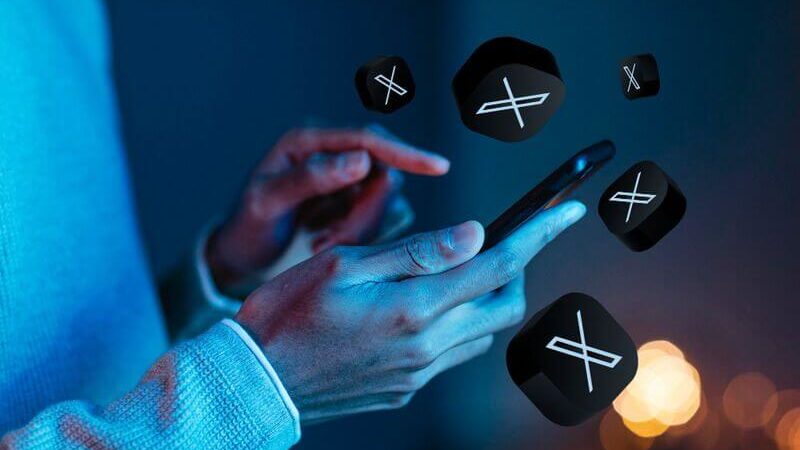Twitter Scams In 2024 – How to Spot and Avoid Them

Image by Freepik
Social media scams can become so predictable.
That’s why one Twitter user decided to have a little fun with her scammer.
When a man contacted the woman claiming to be her one true love, she was amused.
When he asked for $3,200 to visit her, she had a better idea. She’d travel to see him.
And that was when her imaginary journey began. She sent a series of pictures of her “travels,” which included crashing in a helicopter and being stranded in the snow.
Of course, she’d never left home. But her tales panicked the scammer, who begged her to stop traveling and simply send her the $3,200 so he could come to her.
It wasn’t the first time the 42-year-old self-proclaimed bored Twitter user had fun with a scammer. Typically, her conversations end with the scammer blocking her. But at least she’s never lost a dime to a Twitter scam.
What Are Twitter Scams?
Social media has become a staple of modern life. Even if you try to avoid it, you can’t help hearing about it.
Twitter is one of the original social media sites. It’s been around since 2006, back when Facebook was new, and MySpace was getting all the attention.
These days, Twitter remains a popular way to keep up with celebrities and network professionally. Those uses make it a target for scammers looking to capture the unique interests and needs of its user base.
Twitter scams may appear as tweets or as direct messages sent through the platform. In some instances, the scam may come through email, text, or phone, but the scammer will have your Twitter account as a target.
There are multiple Twitter scams, and some match the fraud attempts on platforms like Snapchat, Instagram, YouTube, Reddit, and Facebook. Some, though, have their Twitter-type twist.
8 Common Twitter Scams in 2024

Image by Freepik
- Phishing Scams
- Twitter Support Scams
- Moneymaking Scams
- Influencer Giveaway Scams
- Partnership Scams
- Follower-Buying Scams
- Cryptocurrency Scams
- Bank Impersonation Scams
1. Phishing Scams
What is it? With phishing, a scammer entices you to click on a link, and then provide information. It can come through email, text, or direct message. One phishing attempt that’s unique to Twitter is the shortened link scam. The character limit has popularized shortened links like those made through Bitly. When you click on a spammer’s shortened link, though, it takes you to a page that asks you to input account or financial information, which is then stolen.
How to spot it: Since all shortened URLs look alike, it can be tough to identify the fakes. Instead, hesitate before inputting information after clicking on a link. If there’s a way to go directly to the website, open a new browser window and do that. It’s well worth it if it will save you time.
How to avoid it: Always be suspicious of a form or login page that comes after you’ve clicked on a link. Make sure you trust the source. Even if you’re clicking from a Twitter profile you trust, keep in mind that the profile could have been hacked.
2. Twitter Support Scams
What is it? I’ve been on Twitter for at least a decade and never had a problem with my account. (It could be that I’m not all that active on there, though!) But social media sites are going to act up sometimes, and when they do, you want support. In this scam, someone claiming to be Twitter support reaches out about an “issue with your account.” It’s an issue you didn’t even know you had. You’ll be asked for your username and password (or other sensitive information) to fix the problem, and the scammer will take the information and run.
How to spot it: You can sometimes tell a fake email by its grammatical errors and misspellings. The email header may also have a clue or two. But it’s important to note that Twitter will never ask for your password or other sensitive data. If you suspect something might be wrong with your account, contact Twitter support here.
How to avoid it: Never provide sensitive data, including usernames and passwords, in response to an email, text, social media message, or phone call.
3. Moneymaking Scams
What is it? “Make money working from home” invitations were circulating long before the trend toward remote work. With remote work scam, you’re promised a great opportunity to work from home. First, you’ll need “to pay a small up-front fee for a starter kit.” This money goes into the scammer’s pocket.
How to spot it: The language of these ads is typically overly enthusiastic, promising easy money. The fake employer may even use the credit card information you’ve provided to commit fraud.
How to avoid it: Stick to job sites for your career searches. If you spot an offer that intrigues you, contact the company directly, and never give money or financial information as part of a job application.
4. Influencer Giveaway Scams
What is it? Like Instagram, Twitter is all about influencers. Whether they’re celebrities or just have a lot of followers, these users are able to get free products and money in exchange for shout-outs. These accounts are also targets for scammers, who hack or clone accounts, and then use those accounts to scam other users. This may be done in the form of a giveaway, where you’re told you’ve won and simply need to provide a credit card number to claim your prize.
How to spot it: Hackers typically don’t have the professionalism your favorite influencer has. Posts and comments may be riddled with typos and rely on the overuse of emojis and strange fonts. But the biggest red flag is a request for financial data. There’s no reason you should have to provide a credit card number to another Twitter user.
How to avoid it: Always say “no” to requests for financial data. Keep in mind at all times that accounts can be hacked, so the person on the other end of the computer might not be the person you think.
5. Partnership Scams
What is it? This scam makes you the influencer, whether you have only 100 followers or 100,000. Someone reaches out to you with a partnership offer, promising money, products, or more. But first, you’ll need to provide some account information or pay an upfront fee. Once you’ve done that, the scammer vanishes with your money and/or account information.
How to spot it: Brands are looking for Twitter users who can reach a large number of people and potentially influence purchases (a.k.a. influencers). If you don’t have that kind of power, always be suspicious of sponsorship offers. Also, there’s no reason anyone on Twitter should request your passwords or banking information.
How to avoid it: Never send anyone passwords or banking account numbers. If someone needs your Social Security number for tax purposes, thoroughly investigate the opportunity before providing it.
6. Follower-Buying Scams
What is it? It can take time to build a following on any social media platform. Wouldn’t it be nice to take a shortcut? That’s what this scam pretends to provide. For a fee, you can buy followers. Scammers will promise “quality followers,” but there’s no guarantee that’s what you’ll get. The biggest issue, though, is that Twitter prohibits artificially inflating your followers, and it could result in permanent suspension.
How to spot it: You don’t have to look far to find someone trying to sell followers. If you see a tweet or message promising to boost your followers, chances are that person will ask for some money.
How to avoid it: Put the work into getting followers without buying them. They’ll be quality followers, and you’ll keep your money in your bank account.
7. Cryptocurrency Scams
What is it? As cryptocurrency has grown in popularity, it’s become a target for scammers. They use Twitter to reach out to users, asking for help with an account. You’ll log in and try to help, but to retrieve the money, you’ll need to input your own cryptocurrency wallet details. Those credentials are stolen, and your wallet is emptied.
How to spot it: Typically, these scammers are directing you to cryptocurrency wallets with names that don’t match their own usernames. You may also see discrepancies in the design of the fake cryptocurrency page.
How to avoid it: Never log into your cryptocurrency wallet based on a link. Say “no” to any requests to log into someone else’s financial accounts.
8. Bank Impersonation Scams
What is it? Twitter users routinely tag their banks in complaints on the platform. As with other large companies, banks often have a customer service representative assigned to invite complainers to get in touch. This scam has fraudsters creating lookalike accounts for big banks, then swooping in to grab those complaint tweets. You’re given a phone number to call, but that phone number takes you directly to the scammer, who then asks for your account details to “fix” the problem.
How to spot it: Now that account verification is gone, it’s tough to spot authentic accounts on Twitter. It’s best to take your complaints directly to the bank in question. If you tweet a complaint and get an invitation, remember that your bank won’t ask for full account numbers or passwords.
How to avoid it: Refuse to provide your full account number or password, especially if it’s through someone you contacted based on a tweet.
How to Keep Twitter Scammers Away?

Image by Freepik
The longer you’re on Twitter, the greater the possibility you’ll experience a scam attempt. Here are some things you can do to protect yourself.
1. Set Up Multifactor Authentication
Multifactor authentication can help protect your online identity.
Here’s how it works:
Whenever an unfamiliar device tries to log into one of your accounts, a verification message will be sent to a secondary device you’ve set up. So, you might try to log in on your new smartphone, but you’ll have to verify it on your laptop or in your email first.
Twitter offers two-factor authentication. If someone tries to break into your Twitter account, not only will they be unable to do so, but you’ll get an alert on your secondary device that someone tried to log in.
Here’s how to set up two-factor authentication on Twitter:
Twitter has done away with the text message option for non-verified users, so you’ll need to choose an authentication app or send a security key to your mobile device.
2. Inspect Twitter Accounts Carefully
At one time, Twitter was strict about its blue check. If your cable company or bank had that blue checkmark, chances were pretty good that it was the actual account.
But Twitter is taking that blue checkmark away for those who aren’t paid, subscribers. So your bank and cable company will have to pay to be verified. This means someone using the same name could snatch up that blue checkmark for a fee.
That makes it all the more important to check the profile of anyone contacting you, blue checkmark or not.
Look for a profile with a picture, bio, and a history of original tweets. Fake accounts will often retweet constantly to give the appearance of an activity history.
You can also try inputting the business’s/person’s name in the search box. You’ll be able to see all the profiles associated with that name to ensure the person messaging you or replying to your tweets is legitimate.
Lastly, take a look at the profile’s followers, as well as who the profile is following. Pay close attention to whether those followers are legitimate.
3. Don’t Trust Twitter Messages
That email or text, claiming to be from Twitter, may be from a scammer. To be safe, never click on a link or reply to a Twitter email. If a message claims there’s a problem with your account, go to the app or Twitter.com and take a look at things.
But if you want to verify the authenticity of a Twitter message, here are some things to note:
All Twitter messages will come from @twitter.com or @e.twitter.com. But email addresses can be spoofed.
The Twitter emblem can also be spoofed.
Twitter will never ask you to provide your password in an email. If a link takes you to a landing page that asks for a login, assume you’re being phished.
Twitter also never sends attachments in emails.
What to Do if You’ve Been Scammed on Twitter?
Maybe you’ve been hit with a scam. Or perhaps someone tried unsuccessfully to scam you. Either way, it’s crucial to take action as soon as possible.
1. Report the Scam
Twitter cracks down on activities that violate its policies. One of those policies is its financial scam policy. It goes like this:
No account can use the platform to manipulate users for financial gain.
Reporting this kind of activity is easy. Simply choose the down arrow next to the tweet and select Report tweet. Click on It’s suspicious or spam from the options. You’ll then let Twitter know what seems sketchy about it.
If you’re at the other end of a fake Twitter email, Twitter advises you to delete it without clicking or downloading simply.
You can also report an account for scammy activity by following these steps:
You can block the user from the same list of options.
2. Change Your Password
If you’re on a scammer’s radar, there’s a possibility your account will be hacked.
Twitter recommends a 10-character or greater password that combines letters, numbers, and special characters. Make it an original password that you use for no other sites.
Have trouble keeping up with all those passwords? Services like Bitwarden, NordPass, or 1Password can securely store them all and automatically log you in with each visit.
Even if you haven’t been scammed, take a second to update your password and enable two-factor authentication. You can never be too safe.
3. Protect Your Identity
If the scam extends beyond your Twitter account and someone has grabbed your personal information, take action as soon as possible.
First, contact your bank if you believe your credit card number or bank account might be in the wrong hands. You should cancel the account or at least have the bank look out for suspicious activity.
Second, keep an eye on your credit report. Someone might try to apply for new credit, assuming you’ve provided your Social Security number.
Third, consider identity theft protection. Companies like Aura, LifeLock, and IdentityForce will not only help cover you if your identity is stolen, but they’ll also keep a lookout. This can help you identify fraudulent activity early.
Conclusion
Twitter can be a great way to pass the time or professional network.
But it can also be a feeding ground for scammers.
By understanding the risks and taking measures to keep your accounts safe, you can enjoy the best of Twitter and avoid the worst. Over time, you’ll learn to easily spot the scams and quickly disengage, report, and block them.
Other Social Media Scams You Should Know:



